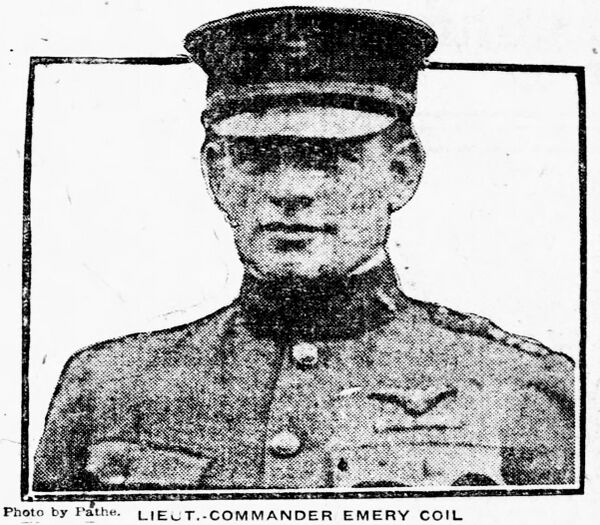EMORY W. COIL, LCDR, USN
Emory Coil '12
Lucky Bag
From the 1912 Lucky Bag:
Emory Wilbur Coil
Marietta, Ohio
"Wheel" "Stug"
"WHEEL" left Marietta early and got a big start in the graduation Marathon, but "Pap" and Mr. Rheumatism set him back two laps, and now he is even with us. The "Rooster Bill" of the class, he can remember when some of our Divisional Officers were first classmen. If anyone comes up behind you and squeezes your chest in, you know it's Stug, with the famous "Bear Hug." Either prepare for a pluperfect rough house or yell for help!
Owing to an extreme aversion to work, he has never done much except play on his mandolin. Occasionally drags to help Toots, but he's not bothered very much that way.
Owing to a recent disaster, he has renounced the world, hence the following:
"Emory Wheel! Emory Wheel! Shame on you!
You don't do like you used to do;
You used to always call for more,
But now you ain't no reservoir!"
Buzzard; Lacrosse Numerals

Emory Wilbur Coil
Marietta, Ohio
"Wheel" "Stug"
"WHEEL" left Marietta early and got a big start in the graduation Marathon, but "Pap" and Mr. Rheumatism set him back two laps, and now he is even with us. The "Rooster Bill" of the class, he can remember when some of our Divisional Officers were first classmen. If anyone comes up behind you and squeezes your chest in, you know it's Stug, with the famous "Bear Hug." Either prepare for a pluperfect rough house or yell for help!
Owing to an extreme aversion to work, he has never done much except play on his mandolin. Occasionally drags to help Toots, but he's not bothered very much that way.
Owing to a recent disaster, he has renounced the world, hence the following:
"Emory Wheel! Emory Wheel! Shame on you!
You don't do like you used to do;
You used to always call for more,
But now you ain't no reservoir!"
Buzzard; Lacrosse Numerals
Loss
Emory was lost on August 24, 1921 when the British-built airship R-38, intended for US Navy use as ZR-2, crashed near Hull, England. Forty-four of the forty-nine men aboard died.
Other Information
From researcher Kathy Franz:
Born in Westborough, Massachusetts, Emory and his family later moved to Cincinnati and then to Marietta, Ohio. Emory graduated from Marietta High School. His name appeared with other graduates in the 1918 yearbook as those who were in the service.
Emory married Mildred O’Connell on October, 16, 1916, in Tucson. She was the stepdaughter of General L. H. Manning. In December 1918, Emory had pneumonia and was taken to the naval hospital in Washington, D. C. Shortly thereafter, his wife, one-year-old daughter Mildred Lovell Coil, and sister Mrs. H. W. Bard were also brought in with pneumonia. Mrs. Bard died, and a day later, his wife Mildred died. Their daughter then lived with General and Mrs. Manning in Tucson in the winter and Hollywood in the summer. In 1921 at the same Hollywood house, Mrs. Gladys Witherell was kidnapped.
Emory’s second wife was an English actress, May Edith Lawne of London (stage name may have been Tresmond.) They married in 1920, in St. George, Hanover Square. She was in England with him at the time he died. She was looking forward to the trip to America on the dirigible. She honored his wishes to be buried at sea, and on September 18, 1921, she arrived from England on the S. S. Caronia.
The British cruiser Dauntless took the bodies of the Americans to America. Emory’s casket was loaded on the destroyer Breck, and he was slipped into the sea 100 miles southeast of Sandy Hook on September 20, 1921.
A bronze tablet honoring Emory was dedicated on January 18, 1922, in Annapolis. During this time, his widow had been the guest of the Aide to the Superintendent and Mrs. Mahlon Tisdale. She was next to visit Lieutenant Commander and Mrs. Richard Byrd.
In July 1922, Emory’s widow sailed on the St. Paul with a naval party. The group was headed to Geneva, Switzerland, where they would take part in the International Gordon Bennett Cup race on August 6. For the past few months, she had been the guest of Chief Machinist and Mrs. S. S. Halliburton at Lakehurst, New Jersey. Over the next few years, she sailed back and forth to England several times. In 1923, she listed her address as Marietta, Ohio. In 1926, she lived at 715 Madison Avenue in New York City. In 1935, she married David E. Treharne, a coal merchant, in Wandsworth, London.
In July 1928, newspapers published a journal by Richard E. Byrd (’12). He wrote about his classmate and close friend Emory. When Emory was ill with pneumonia, Byrd said he reached for a newspaper and read that his mother and wife had died. Twice more our paths would cross under the shadow of disaster. In 1919, Emory took command of the C-5. Byrd had turned over to him all the navigational data and one each of the instruments developed for the big flight. Byrd thought he would be on the C-5 as well, but a storm ended the C-5. Byrd reached London on August 20, 1921. He telephoned Commander Maxfield and asked him to put him on the list for the trial flight of the ZR-2. But he missed the morning train for Howden and did not arrive until the night of the 22nd. Commander Maxfield had taken his name off the list.
From the book Race to the Top of the World: Richard Byrd and the First Flight to the North Pole (pages 232-233.)
“No one was more concerned than Coil, the X. O. Emory Wilbur Coil, a fair-haired, exuberant fellow, played the mandolin and habitually wrapped his buddies in bear hugs. He had been turned back one year at the Naval Academy and consequently graduated with Byrd’s class instead of with the class of 1911. Bad luck had continued to plague him. He had lost both his wife and mother early in 1919 and had since remarried. Later that year, he had been given command of the dirigible C-5, the airship to which Byrd was supposed to transfer after the NC’s had reached Trepassey. Coil had lost the C-5 to a raging wind and with it his chance to mount the world’s first non-stop transatlantic flight. He had a premonition that the ZR-2 would never reach the States. Another crewman had dreamed that the ship blew up over the River Humber.
“On the morning of the flight, Byrd boarded the dirigible with Coil. They climbed up from the control car to the envelope and proceeded down a central ramp that spanned a distance equivalent to the length of three city blocks. On either side of the walkway loomed the monstrous bladders swollen with the hydrogen gas that lifted the ship.”
Emory’s father 1858 was pastor of the First Unitarian Church of Marietta and Grand Chancellor of the Knights of Pythias of Ohio. His mother was Sarah Kate, and his siblings were Harold, who named his son Emory Alfred Coil, Alfreda, and Marion.
He was buried at sea from USS Breck (DD 283) on September 20, 1921. Emory has a memory marker in Arizona.
His wife, Mildred, died in 1919.
Photographs
Memorial
On July 2, 1943, at a celebration for the christening of the newest Goodyear-built K ship, Emory and eight other men lost in lighter-than-air flight were honored with a memorial tablet on a granite rock at the Wingfoot Lake station at Suffield, Ohio. The other honorees were: CDR Louis Maxfield '07, on the British ship ZR-2 in 1921, LCDR Zachary Lansdowne '09 in the Shenandoah crash in 1925, LT Charles Bauch on the U.S.S. Akron in 1931, LT Arthur R. Houghton in 1925, LT Henry Hoyt '14 in 1921, LT J. B. Lawrence in 1925, LT C. G. Little in 1921, and LT Frank Trotter '23 in 1942.
Career
Emory became naval aviator #96 in 1917.
At some point in 1917 he was on the staff of the first Navy lighter-than-air instructors.
From Naval History and Heritage Command:
14 May [1919] Lt. Cmdr. Emory W. Coil commanded the airship C-5 during a record flight for nonrigid airships from Montauk Point, Long Island, N.Y., to Pleasantville, St. Johns, Newfoundland, covering 1,050 nautical miles in 25 hours 50 minutes. Coil and his crew of six made the nonstop voyage to determine whether they were able to cross the Atlantic, and determined that such a flight would be feasible. However, shortly following C-5’s arrival a heavy gale sprang up, and despite efforts to deflate the bag, the gale tore the airship from the moorings and swept her to sea. The two sailors on board jumped clear and survived.
Related Articles
Lewis Maxfield '07, Valentine Bieg '10, and Henry Hoyt '14 were also lost when ZR-2 crashed.
The "Register of Commissioned and Warrant Officers of the United States Navy and Marine Corps" was published annually from 1815 through at least the 1970s; it provided rank, command or station, and occasionally billet until the beginning of World War II when command/station was no longer included. Scanned copies were reviewed and data entered from the mid-1840s through 1922, when more-frequent Navy Directories were available.
The Navy Directory was a publication that provided information on the command, billet, and rank of every active and retired naval officer. Single editions have been found online from January 1915 and March 1918, and then from three to six editions per year from 1923 through 1940; the final edition is from April 1941.
The entries in both series of documents are sometimes cryptic and confusing. They are often inconsistent, even within an edition, with the name of commands; this is especially true for aviation squadrons in the 1920s and early 1930s.
Alumni listed at the same command may or may not have had significant interactions; they could have shared a stateroom or workspace, stood many hours of watch together… or, especially at the larger commands, they might not have known each other at all. The information provides the opportunity to draw connections that are otherwise invisible, though, and gives a fuller view of the professional experiences of these alumni in Memorial Hall.
January 1913
January 1915
January 1916
January 1917
March 1918
January 1919
January 1920
January 1921

The "category" links below lead to lists of related Honorees; use them to explore further the service and sacrifice of alumni in Memorial Hall.




